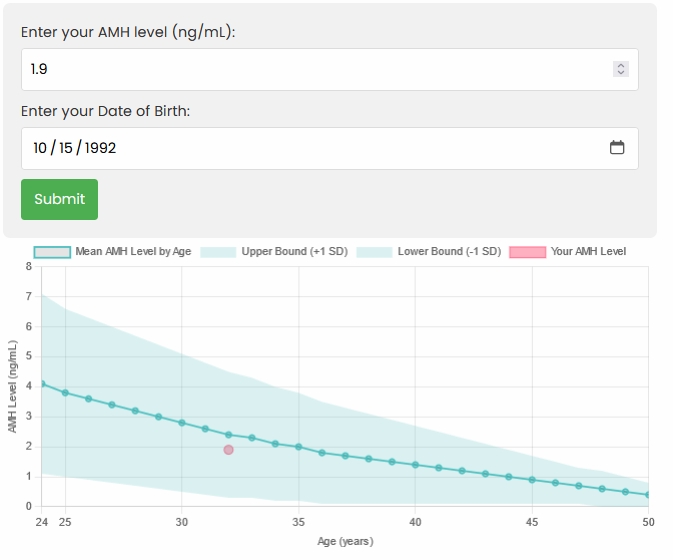Check Your AMH Online: Introducing the AMH Level Checker
When you’re trying to conceive, it can feel like navigating a maze, and understanding your fertility can be overwhelming. In an effort to make this journey a little easier to understand, I’m excited to introduce a new calculator to the Lucky Egg blog—the AMH Level Checker. This tool takes your age and AMH level, compares it with a large dataset of AMH values from women across the U.S., and helps you see where you fall in the spectrum of typical AMH levels for your age group. A more apt name for the tool might be the “AMH Level Setter”, as its not about checking your AMH, but rather seeing here your value lands amongst the other women of a similar age.
My name is Dr. Lucky Sekhon and I am practicing REI in New York. In my practice, I help hundreds of women each year preserve their fertility and overcome infertility through treatments such as egg freezing and IVF. The AMH Level Checker is my newest calculator I’ve created for this blog, joining other popular tools I’ve created like the IVF Due Date Calculator, the Beta hCG Calculator, the Egg Freezing Success Calculator, and the Euploid Embryo Predictor. Please follow me on Instagram or subscribe to my newsletter to stay on top of my latest fertility and reproductive health content.
What Does AMH Tell Us?
Your AMH level gives an idea of your ovarian reserve, or the number of eggs you have in your ovaries. Higher AMH levels usually mean you have more eggs remaining, while lower levels indicate a lower ovarian reserve. However, it’s important to note that AMH levels do not predict your ability to get pregnant, but rather provide insight into the quantity of your egg supply.
Women naturally experience a decline in AMH as they age, and this is completely normal. AMH is not a static number; it fluctuates and changes with time, just like other aspects of your fertility.
What Does the AMH Level Checker Do?
The AMH Level Checker helps you compare your AMH level with the average range for women in your age group based on data from a study that included over 17,000 women across the U.S. This tool plots your AMH value within a “range band” that represents the mean (average) and the standard deviation (a measure of how much AMH values vary from the average) for women of the same age.
For example, let’s say you’re 32 years old with an AMH level of 1.9 ng/mL. The AMH Level Checker would plot your value on a chart showing where the mean AMH level is for women aged 32 (2.4 ng/mL), and how your value compares to the typical range (within one standard deviation) above or below that mean.

In this case, the AMH of 1.9 ng/mL is slightly below the average of 2.4 ng/mL. However, it lies within shaded area (corresponding to 1 standard deviation unit) that tells us that even though its below the mean, it is still within the range of values normally seen at this age.
What Are Mean and Standard Deviation?
If your memory of high schools statistics is a bit hazy, that’s ok, let me break down the concepts of mean and standard deviation.
Mean: The mean is simply the average of a set of numbers. In the context of AMH levels, the mean for each age group is the average AMH level for all the women in that age bracket.
For instance, if five women in their early 30s have AMH levels of 1.8, 2.1, 2.5, 2.8, and 3.0 ng/mL, the mean AMH level for that group would be the average of those numbers, which is 2.44 ng/mL.
Standard Deviation: This is a measure of the variation or spread in the data. It tells us how much individuals’ AMH levels tend to deviate from the average (mean). In other words, if most women in an age group have AMH levels close to the mean, the standard deviation will be small. If there’s a wider variety of AMH levels, the standard deviation will be larger. For example, if the mean AMH for women aged 32 is 2.4 ng/mL, and the standard deviation is 1.0 ng/mL, most women will have AMH levels that fall within one standard deviation of the mean—that is, between 1.4 ng/mL and 3.4 ng/mL. This range is represented on the graph by that shaded band.
By plotting your AMH on a graph that includes the mean and one standard deviation above and below, the AMH Level Checker gives you a better understanding of how your result compares with others in your age group. If your AMH falls within the range of one standard deviation above or below the mean, this is considered typical for your age group. If your AMH is higher than this range, it could indicate a higher ovarian reserve than average. If it’s lower, it suggests a lower-than-average ovarian reserve for your age.
What Does It Mean If You’re Outside the Range?
It’s important to remember that being outside the range doesn’t mean you won’t be able to conceive. Many women with lower AMH levels still conceive successfully, and AMH alone doesn’t determine your overall fertility. If you are looking to conceive on your own or through IUI, your AMH level along is largely irrelevant. It’s just one piece of the larger fertility puzzle, which includes other factors like egg quality, the health of your reproductive system, and your partner’s fertility. Please see my article dispelling the myth that AMH is a ‘all in one fertility test’ for more information.
If you find your AMH level is lower than expected, it may prompt further investigation with a fertility specialist. I often recommend pairing your AMH results with other tests like an antral follicle count (AFC) or FSH (follicle-stimulating hormone) to get a more complete picture of your fertility health.
Conclusion
I hope this tool gives you more clarity and confidence as you navigate your fertility journey. Remember, every woman’s fertility story is different, and no single number or statistic can fully capture your reproductive health. Remember, this tool is just for educational purposes only and not a substitute for guided, personalized care by a trained REI. If you are interested in booking a fertility consultation with me, please submit a request here.
If you would like to keep up with my latest fertility and reproductive health content, please follow me on Instagram as I post new content daily. Also, subscribe to the ‘Lucky Egg Drop’, my fertility newsletter where I share my latest updates on fertility news, advancements as well as a peek into my everyday life.

